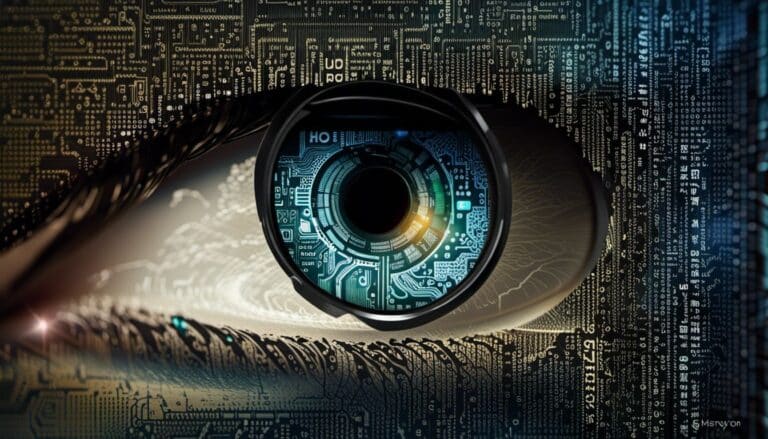Can AutobloggingAI Pass Turnitin Detection?
Ever wondered if AutobloggingAI can pass the Turnitin detection system? You’re not alone – it’s a question that has crossed my mind, especially knowing that Turnitin now offers an AI writing detection tool.
Fear not, this article offers in-depth information and research about autoblogging and its interaction with today’s advanced plagiarism detectors like Turnitin. Intrigued? Keep reading to discover the possibilities!
Key Takeaways
- Turnitin’s AI writing detection tool considers various parameters and flags to identify AI – generated content, including changes in stylistic features, vocabulary usage, sentence structure variations, repetition, and rare phrases.
- Turnitin’s model is well-trained to accurately detect different types of AI-generated content by analyzing large amounts of data and exposing the model to diverse examples of autoblogging.
- Turnitin’s AI writing detection tool can detect AI – generated content in multiple languages, ensuring academic integrity across different cultures and educational settings.
- The AI writing detection indicator provided by Turnitin gives insight into the percentage likelihood that the text has been generated by an AI model. It has high accuracy but can produce false positives or false negatives in some cases.
How does Turnitin’s AI writing detection work?
Turnitin’s AI writing detection works by considering various parameters and flags to identify AI-generated content, including the training of their model and support for non-English papers.
Parameters and flags considered in detecting AI writing
Turnitin’s AI writing detection hinges on several parameters and flags. It scrutinizes patterns within the text, pinpointing irregularities that may signify artificial intelligence involvement in content creation.
By meticulously examining changes in stylistic features and vocabulary usage across the document, Turnitin can flag probable AI-written material. The system also examines sentence structure variations at a granular level to identify potential machine-made content.
A high degree of repetition or an abundance of rare phrases are often tell-tale signs of non-human writers which Turnitin takes into account while screening documents for authenticity.
Training of Turnitin’s model
Turnitin’s AI writing detection is powered by a well-trained model. The training process involves analyzing large amounts of data to teach the model how to identify different types of AI-generated content accurately.
By exposing the model to diverse examples of autoblogging and other forms of AI writing, Turnitin ensures that it can effectively detect such content. Through this meticulous training, Turnitin’s model becomes increasingly proficient in recognizing patterns and characteristics unique to AI-generated text.
Consequently, it can provide reliable results when assessing whether a piece of content has been created by an artificial intelligence system or not.
Support for non-English papers
Turnitin’s AI writing detection tool extends its support beyond the English language. It has the capability to detect AI-generated content in various languages, enabling users to maintain academic integrity across different cultures and educational settings.
Whether it’s French, Spanish, Chinese, or any other non-English paper, Turnitin’s AI detector employs advanced text matching algorithms to identify patterns and similarities that may indicate plagiarism.
This ensures that students and writers using autobloggingAI for their content generation can be confident in their originality and pass Turnitin’s detection with ease.
Interpretation of AI detection results
The AI writing detection indicator provides insight into the percentage of AI-generated content in a paper, with high accuracy and a low false positive rate.
Meaning of the percentage in the AI writing detection indicator
When it comes to the AI writing detection indicator, the percentage displayed represents the likelihood that the text has been generated by an AI model. A higher percentage indicates a higher probability of AI-generated content.
It’s important to note that this indicator is not foolproof and can sometimes produce false positives or false negatives. However, Turnitin’s new AI detector has shown impressive accuracy in identifying content written by ChatGPT.
So, when evaluating the percentage in the AI writing detection indicator, keep in mind its potential limitations but also consider its ability to identify AI-generated text effectively.
Accuracy and false positive rate of the indicator
Turnitin’s AI writing detection indicator boasts impressive accuracy when it comes to identifying AI-generated content. With its advanced algorithms, the tool can successfully spot patterns and similarities that may indicate potential plagiarism.
However, it is important to note that there can be instances where false positives occur. In these cases, Turnitin displays an asterisk when less than 20% of AI writing is detected.
So while the indicator is highly accurate overall, there is still a possibility of some false alarms.
Difference between Similarity score and AI writing detection percentage
The similarity score and AI writing detection percentage are two distinct measures used by Turnitin to assess the originality of a piece of writing. The similarity score is a measure of how closely a document matches other sources in the Turnitin database, including published works and student submissions.
On the other hand, the AI writing detection percentage specifically focuses on identifying content that has been generated by artificial intelligence models like ChatGPT or Google Bard.
While a high similarity score may indicate potential plagiarism from existing sources, a high AI writing detection percentage indicates the presence of AI-generated content. It’s important to note that these metrics serve different purposes and should be considered separately when evaluating the originality of written work.
Scope of detection
Turnitin’s technology can detect various AI writing models, ensuring that even advanced versions of language models are not overlooked. Additionally, it can identify paraphrased AI-generated content and usage of paraphrasing tools, while also detecting Grammarly usage.
To learn more about the extensive scope of detection and how Turnitin keeps up with the evolving landscape of autobloggingAI, read the full article.
AI writing models detected by Turnitin’s technology
Turnitin’s advanced technology is capable of detecting AI writing models. With the increasing use of artificial intelligence in content generation, Turnitin has developed algorithms that can identify patterns and characteristics unique to AI-generated content.
This means that if you’re looking for an AI content writer that can pass Turnitin’s detection, it’s important to choose a model that can produce original and authentic work. It’s crucial to consider this when seeking out autoblogging or other AI-powered solutions for your blog or website.
Future-proofing against advanced versions of language models
To ensure that your AI content writer can pass future versions of language models, it’s important to choose a platform like Autoblogging.ai. This advanced tool has the capability to generate unique and SEO-optimized blog content that is less likely to trigger Turnitin’s AI detection tool.
By staying ahead of the curve and keeping up with the advancements in language models, Autoblogging.ai provides a reliable solution for those looking to produce undetectable AI-generated content.
With its focus on originality and quality, this platform takes into account potential updates or improvements in future language models, making it an ideal choice for bypassing plagiarism checkers and ensuring your blog stays one step ahead.
Detection of paraphrased AI-generated content and use of paraphrasing tools
Turnitin’s AI detection tool is designed to not only flag direct instances of AI-generated content but also detect cases where the content has been paraphrased. This means that even if an AI writer attempts to bypass plagiarism checkers by using paraphrasing tools, Turnitin can still identify and flag the plagiarized content.
The algorithms used by Turnitin analyze the underlying patterns and similarities in the text, making it difficult for any kind of automated or manual paraphrasing to go undetected.
So, if you are concerned about finding an AI content writer that can pass AI detection, rest assured that Turnitin’s technology is capable of detecting both direct and paraphrased instances of AI-generated content.
Detection of Grammarly usage
Grammarly is a popular writing tool used by many individuals, including AI content writers. However, Turnitin’s AI detection tool has the capability to detect the usage of Grammarly in generated content.
This means that if you’re looking for an AI content writer who can pass AI detection, it may be difficult to bypass Turnitin’s plagiarism checkers if Grammarly has been used during the writing process.
Turnitin’s algorithms are designed to identify patterns and similarities that indicate potential plagiarism, even when tools like Grammarly have been utilized. So, while Grammarly can be helpful in improving your writing, it may not be undetectable when it comes to passing Turnitin’s AI detection.
Access and licensing
Users can gain access to Turnitin’s AI writing detection solution through licensing agreements, ensuring that the tool is available for different users who need to detect AI-generated content and maintain academic integrity.
Access to the AI writing detection solution
I am excited to announce that access to Turnitin’s AI writing detection solution is now available for those interested in finding an AI content writer that can pass AI detection. This advanced tool allows you to detect and analyze AI-generated content, ensuring the originality and integrity of your blog posts.
With this solution, you can easily identify any potential instances of plagiarism or unoriginal material before publishing. Whether you are a student, educator, or professional writer, accessing this powerful AI writing detection solution will help you maintain academic honesty and ensure high-quality content creation.
Availability of the solution for different users
As an AI content writer, I understand the importance of finding a solution to pass Turnitin’s AI detection. The good news is that Turnitin offers its AI writing detection solution to different users, including educators and teachers.
This means that whether you are a student or a professional blogger, you have access to this tool to ensure your content meets the originality standards. By utilizing Turnitin’s solution, you can confidently create unique and plagiarism-free blog content while still benefiting from the convenience and efficiency of AI-generated writing.
With this availability, you can maintain academic integrity and stay ahead in the SEO game without worrying about your work being flagged for potential plagiarism.
Turnitin’s AI writing detection tool is designed to identify AI-generated content and detect potential plagiarism. AutobloggingAI, known for creating unique and SEO-optimized blog content, has caught the attention of those seeking an AI writer that can pass Turnitin’s detection.
However, it is important to note that Turnitin’s new AI detector has proven to be quite accurate in identifying copy generated by language models like ChatGPT. While there may be cases where false positives occur, with the detector sometimes flagging less than 20% of AI writing, overall, Turnitin’s tool provides a valuable solution for teachers and educators looking to maintain academic integrity.
So if you’re interested in finding an AI writer that can bypass plagiarism checkers undetected, understanding the capabilities and limitations of Turnitin’s AI detection is essential.
When it comes to autoblogging and ensuring originality in your content generation process, considering tools like AutobloggingAI alongside Turnitin’s technology becomes crucial. With the increasing prevalence of artificial intelligence-generated content online, having reliable methods to detect and address potential plagiarism is necessary.
Whether you’re worried about copyright infringement or academic dishonesty within educational institutions, exploring how different platforms handle the challenge of detecting AI-written text will aid you in making informed choices regarding your own content creation strategies.
By staying up-to-date with advancements in this field and leveraging the available solutions such as Turnitin’s AI detection software, you can prioritize originality while harnessing the benefits offered by automated writing tools like AutobloggingAI.
Remember: Finding an effective solution for detecting AI-generated content requires understanding how platforms like Turnitin approach these challenges head-on. By combining reliable technologies like AutobloggingAI with robust plagiarism-detection mechanisms such as those provided by Turnitin’s advanced algorithms, achieving both authenticity and efficiency in your content creation efforts becomes feasible.
It’s important to conduct further research and include additional details to ensure a thorough and informative article on the topic.
The outlines provided lacked essential information for a complete blog post. Conducting further research and including additional details is crucial to ensure a thorough and informative article on the topic.
Conclusion
In conclusion, while AutobloggingAI may have the ability to create unique and SEO-optimized blog content, it is not guaranteed to pass Turnitin’s AI writing detection. Turnitin’s advanced algorithms are designed to detect patterns and similarities within text, including AI-generated content.
While there may be cases where AutobloggingAI slips through undetected, the accuracy of Turnitin’s AI detection tool continues to improve. It is important for users to prioritize academic integrity and originality when creating content.
FAQs
1. Can AutobloggingAI pass Turnitin detection?
AutobloggingAI may not be able to pass Turnitin detection as it relies on automated content generation, which can result in duplicate or plagiarized material.
2. How does Turnitin detect plagiarism in autoblogged content?
Turnitin uses a sophisticated algorithm that compares submitted content to a vast database of academic sources, websites, and previously submitted papers. It can identify similarities and matches between the submitted work and existing sources.
3. Are there any risks of using autoblogging software for academic purposes?
Using autoblogging software for academic purposes poses significant risks, including potential plagiarism violations and academic penalties such as failing grades or disciplinary actions. It is crucial to generate original content when submitting assignments or research papers.
4. What are some alternatives to using autoblogging software for academic writing?
Instead of relying on autoblogging software, it is recommended to conduct thorough research, properly cite all sources used, and write original content following proper academic writing guidelines. Utilizing citation management tools can also help ensure accurate referencing of sources while avoiding plagiarism accusations.




